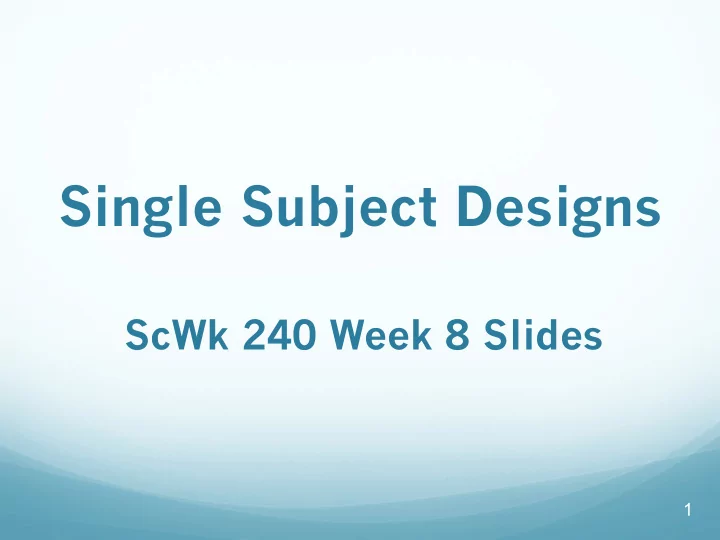

Single Subject Designs ScWk 240 Week 8 Slides 1
Group vs. Single Subject Designs There are two broadly defined approaches to experimental research: group designs & single-subject designs Both approaches apply components of the scientific method to their approach to research The difference between group and single-subject designs lies in the manner in which the principles of the scientific method are put into operation in designing studies 2
Single-Subject Designs -- also called: Single Case and Single System Designs Uses of SSD’s and SCD’s in Social Work Requirements for SSD/SCD’s Target problem identification (DV) Quantification of data Obtaining baselines Graphic display of data Designs(AB, ABAB. ABC/ABCD) and Examples Time Series Designs and Examples External Validity of SSD/SCD’s 3
Use of SSD/SCD’s Designs in SW § Logic of time-series design § Also called single-subject/single- system design, and N=1 studies § Often the most relevant research topics for clinical practitioners § Major limitations: Sample Sizes are small (usually 1) and problems with external validity 4
Setting Target Problems Target problem(s): § Decide desired outcome (=DV) to be measured § Positive or negative indicator? § Should occur frequently enough v Triangulation 5
Developing Measurement Strategies Target problem(s) § Who will measure it? (1) self-monitoring, (2) practitioner, (3) significant others § Sources of data: (1) self-report scale, (2) direct observation, (3) available records v Triangulation with multiple measures and observers are strongly preferred 6
Quantification of Data a) Frequency b) Duration c) Magnitude 7
Obtaining Baseline Phase § Repeated measures before the intervention (=control phase) § Attributes of a good baseline: 1) Minimum of 5-10 measurements 2) Stable 3) Problem is not nearing resolution before the intervention 8
Celeration Lines/Charts Standardized method for charting and analyzing how frequency of behavior changes over time Various Standard Charts: Session/Daily/Weekly/Monthly/Yearly Consistent Display of Celeration (change) Acceleration = increasing performance Deceleration = decreasing performance 9
Interpreting Graphically Displayed Behavioral Data Visual analysis Did behavior change in a meaningful way? If so, to what extent can that change in behavior be attributed to the independent variable? Identification of Variability Level Trend 10
Examples of Baseline Measures 11
Baseline and Intervention Phases 12
Baseline and Intervention Phases 13
Graphic Display of Data § X axis: (horizontal) § Y axis: (vertical) § Data points § Labels: Baseline/A Phase, Intervention phase/B Phase 14
Interpreting Graphically Displayed Behavioral Data Read the graph: Figure caption Condition & axis labels Location of numerical value & relative significance of scale breaks Visually track each data path: Are data paths properly connected? Is the graph distorted? 15
AB Design § The basic and simplest design § One baseline phase & one intervention phase § Advantage(s): § Disadvantage(s): § Retrospective baseline 16
ABAB Design § Withdrawal/reversal design § Advantage(s): § Disadvantage(s): 17
ABAB Design (Examples) 18
Multiple-Component Designs (ABC, ABCD) § Add a third or fourth type of intervention § Caution: carryover effect, order effect, irreversibility effect, history 19
Example of Multiple Component Design 20
Replication § Replication can enhance both internal and external validity. *Be prepared for practical obstacles* 21
Time Series and Related Designs Notations: X = introduction of stimulus, intervention, or treatment O = observation/measurement Time-series design O O O O O X O O O O O 22
Examples of Time Series Projects 23
External Validity • Generalizability • Representativeness of sample, setting and procedures • Sampling and survey research 24
Recommend
More recommend